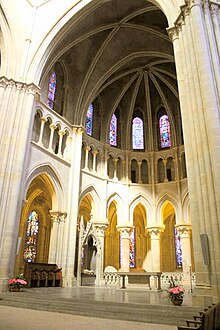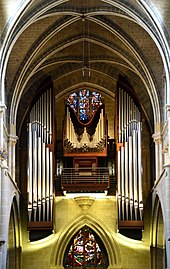Notre-Dame Cathedral (Lausanne)
The Notre-Dame Cathedral in Lausanne , Canton of Vaud ( Switzerland ), is the city's main Reformed church and the Église Évangélique Réformée du canton de Vaud . Before the Reformation it was the episcopal church of the diocese of Lausanne . It is considered to be an important Gothic building in Switzerland and had a decisive influence on the further development of Gothic architecture in the region.
Building history
The cathedral, consecrated to Mary as Our Lady ( French : Notre Dame ), is the successor church to the church that has existed since the 6th century and was consecrated to St. Thyrsus and later called Saint-Maire . The Carolingian building was replaced by a Romanesque church around 1000 . But just a few decades later, construction began again.
There are three construction phases:
- from around 1170 the ambulatory was built in the east
- From about 1190 onwards, the so-called Master of Lausanne built the choir, crossing with lantern tower , transept and a large part of the nave
- Around 1215, the builder Jean Cotereel began completing the nave and building the western end of the church
Around 1225 to 1235, the portail , which is remarkable for its decorative figures and the preserved polychromy , was added to the southern outer wall of the nave. In 1275, the Notre-Dame Cathedral was consecrated in the presence of Pope Gregory X and King Rudolf von Habsburg .
architecture
The cathedral of Lausanne follows the typical scheme of a Gothic basilica : the two-towered western front (only one tower was built) is followed by the three-aisled nave, which crosses the transept in the elevated crossing with a square lantern tower. The choir and access form the eastern end. Despite the various construction phases, the building appears stylistically - for example in the wall structure - quite uniform. However, some special features should be mentioned:
The longitudinal axis of the church given by the ambulatory was shifted slightly in the following construction phases. Furthermore, the first two yokes (wall sections) of the nave are spanned together by a six-part vault, while each yoke is given a four-part ribbed vault in the further course . This change is a sign of the transition from early to high Gothic, which is reflected in the Lausanne Cathedral.
The pillars of the nave are unusually inconsistent. In addition to bundle pillars, there are also the more traditional, massive round pillars. Services that reach up to the vault are also provided for them, but they are not firmly connected to the pillar, but rather stand next to it without any connection.
The westernmost yoke of the nave is also striking. It is wider than the others and has particularly strong supports. These were originally intended to support a single tower in the line of the central nave. After this solution was rejected in favor of a two-tower front, the western nave yoke served as a passage for a street that crossed the church at this point. It was not until the 16th century, under Bishop Aymon de Montfalcon , that the passage was closed.
The construction of the west portal in the flamboyant style (1515–1532) also fell during the term of office of this bishop, but its rich figural decorations had to be completely renewed in the 20th century. Shortly after the entrance, the edging of the original portal can still be seen.
A comparison of the building with the cathedral of Chartres, which was built almost at the same time, or Notre-Dame in Paris (late 12th century) can illustrate its position within the development of the Gothic style.
Furnishing
window
The rose window in the transept, which dates from the early 13th century, is significant . Her pictorial program created by the so-called Master of the Rose of Lausanne encompasses nothing less than a representation of the then known world: earth and sea, air and fire, seasons, months and zodiac signs, as well as monsters lurking on the edge of the world. The remaining stained glass were created by artists of the 19th ( Alfred Gérente ) and 20th centuries ( Ernest Biéler , Louis Rivier and Marcel Poncet ).
Choir stalls and pulpit
The large choir stalls from the 13th century were only partially preserved and are no longer in the cathedral today. A second choir stalls, made under Bishop Aymon de Montfalcon from 1509, can be seen in the St-Maurice chapel (in the substructure of the unfinished northern tower). The pulpit on one of the north pillars of the nave also dates from the 16th century.
Wall painting
In some places (chapel near the rose window, entrance area) there are colored wall paintings. The colored version of the entire interior in gray and ocher tones corresponds to the original condition of the building.
Organs
A four-manual organ of the company Kuhn with membrane loading and pneumatic play and Registertrakturen was inaugurated on October 11, 1903rd In 1935, a Kuhn choir organ followed with two manuals, a pedal and eight registers, which were placed on hanging valve drawers. The game actions were mechanical, the stop actions electric. In 1954, the Kuhn company again installed an interim organ with 12 registers and two manuals in the cathedral and moved it to the Reformed Church of Aesch in 1956 . On November 13, 1955, a new, large organ from the same company played with four manuals, 85 registers, slider chests as well as electric game and electro-pneumatic stop actions.
The current organ system was planned and implemented with the participation of US, Canadian, Swiss, Italian, English and German companies, under the leadership of the US organ building company CB Fisk . Their op. 120 is the first pipe organ from an American company in a European cathedral. Fisk was shortlisted after cathedral organist Jean-Christophe Geiser played various Fisk organs on a concert tour of the USA in 1993, and a replacement for the aging Kuhn main organ was sought. After more than 6 years of planning, including two international tenders, the instrument was completed and inaugurated in December 2003.
2013, from the outset could play table scale, swellable Fernwerk (clavier flottant) originating registers are opened with another 11, from an old Kuhn organ. It is connected to the gaming tables via fiber optic cables. The organ currently has 98 registers (6737 pipes ), divided into five manual works plus remote works and a pedal . It can be controlled from two gaming tables. The organ case was designed by the designer Giugiaro. The organ works can be assigned to four disposition styles: The Positif de Dos is baroque; the other works are arranged in the classical French, symphonic French or romantic German style. Récit expressif and Positif expressif can swell. The playing and stop actions are electric. The instrument is equipped with a programmable register crescendo. The instrument houses a Rossignol (2 pipes) as an effect register. The tremulant of the positif de dos is made as “tremblant doux” (gentle), the tremulant of the recit expressif as “tremblant rapide” (fast).
|
|
|
|
||||||||||||||||||||||||||||||||||||||||||||||||||||||||||||||||||||||||||||||||||||||||||||||||||||||||||||||||||||||||||||||||||||||||||||||||||||||||||||||||||||||||||||||||||||||||||||||||||||||||||||||||||||
|
|
|
|
||||||||||||||||||||||||||||||||||||||||||||||||||||||||||||||||||||||||||||||||||||||||||||||||||||||||||||||||||||||||||||||||||||||||||||||||
-
Couple:
- Normal coupling: I / II, I / III, III / II, IV / II, V / II, IV / III, V / III, I / P, II / P, III / P, IV / P, V / P, Fernwerk / P
- Special coupling: P / II; II / II, III / III, and Fernwerk / Fernwerk (as sub-octave coupling); Fernwerk / Fernwerk (super octave coupling)
- annotation
- K = pipe material from the organ by Kuhn (1955)
restoration
The building material of the cathedral is molasse , a soft sandstone . Its low resistance has meant that almost permanent restoration work has been carried out on the cathedral since its completion.
This work has been fairly well documented since the 18th century. At that time, the complete demolition of the church in favor of a new building was discussed. In the 19th century, the French Gothic specialist Viollet-le-Duc was asked for help. According to his plans, a comprehensive restoration of the entire structure was carried out from 1874, lasting around 60 years. Some of the changes made here were "restored" in the 20th century in favor of greater authenticity. Even at the beginning of the 21st century, efforts to preserve the building continue unabated.
Others
From 1545 Guillaume Franc worked as cantor at the cathedral of Lausanne .
Since 1405 a guet (night watchman, fire watchman ) has been calling out the time at every hour during the night or during part of the night. The tradition arose from fire protection. One of these criers was the well-known cartoonist Mix & Remix .
literature
- Ellen Beer : The rose of the cathedral of Lausanne and the cosmological circle of images of the Middle Ages (= Bernese writings on art. Volume 6). Benteli, Bern 1952.
- Marcel Grandjean, Gae͏̈tan Cassina: The Lausanne Cathedral. Edited by the Society for Swiss Art History . Basel 1975. DNB 99538844X .
- Peter Kurmann u. a. (Ed.): The cathedral of Lausanne and its Marienportal in the context of the European Gothic (= Scrinium Friburgense. Volume 13). De Gruyter, Berlin a. a. 2004, ISBN 3-11-017916-4 .
- Claire Huguenin, Gaëtan Cassina, Marcel Grandjean: The Cathedral in Lausanne (= Swiss Art Guide. No. 695, Series 70). Edited by the Society for Swiss Art History GSK. Bern 2001, ISBN 978-3-85782-695-5 .
Web links
- Information on the building history of the cathedral (French)
- Information about the organs of the cathedral, concert dates (French)
Individual evidence
- ↑ Sophie Donche Gay: Les vitraux du XXe siècle de la cathédrale de Lausanne. Payot, Lausanne 1994, ISBN 2-601-03155-7 .
- ↑ Claire Huguenin, Sophie Donche Gay: Le vitrail des années 1930 dans la cathédrale de Lausanne (= . Swiss art guide No. 737, series 74.). Edited by the Society for Swiss Art History GSK. Bern 2003, ISBN 978-3-85782-737-2 .
- ↑ organ details - Kuhn Organ Builders Ltd. Retrieved August 9, 2019 .
- ↑ organ details - Kuhn Organ Builders Ltd. Retrieved August 9, 2019 .
- ↑ organ details - Kuhn Organ Builders Ltd. Retrieved August 9, 2019 .
- ↑ Text booklet for CD: Vierne / Alain / Langlais: Messes pour Choeurs et deux orgues, page 3 Label: Erato, 1990
- ↑ organ details - Kuhn Organ Builders Ltd. Retrieved August 9, 2019 .
- ↑ More information about the organ and its disposition
Coordinates: 46 ° 31 ′ 21 " N , 6 ° 38 ′ 8" E ; CH1903: 538378 / one hundred fifty-two thousand six hundred and seventy-two




